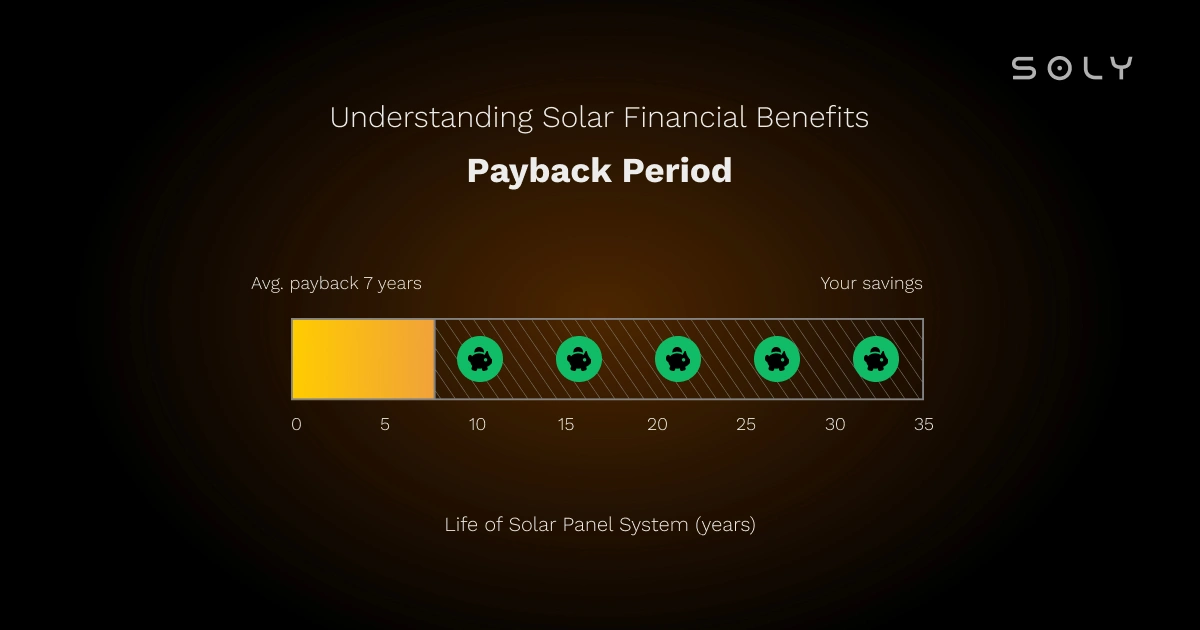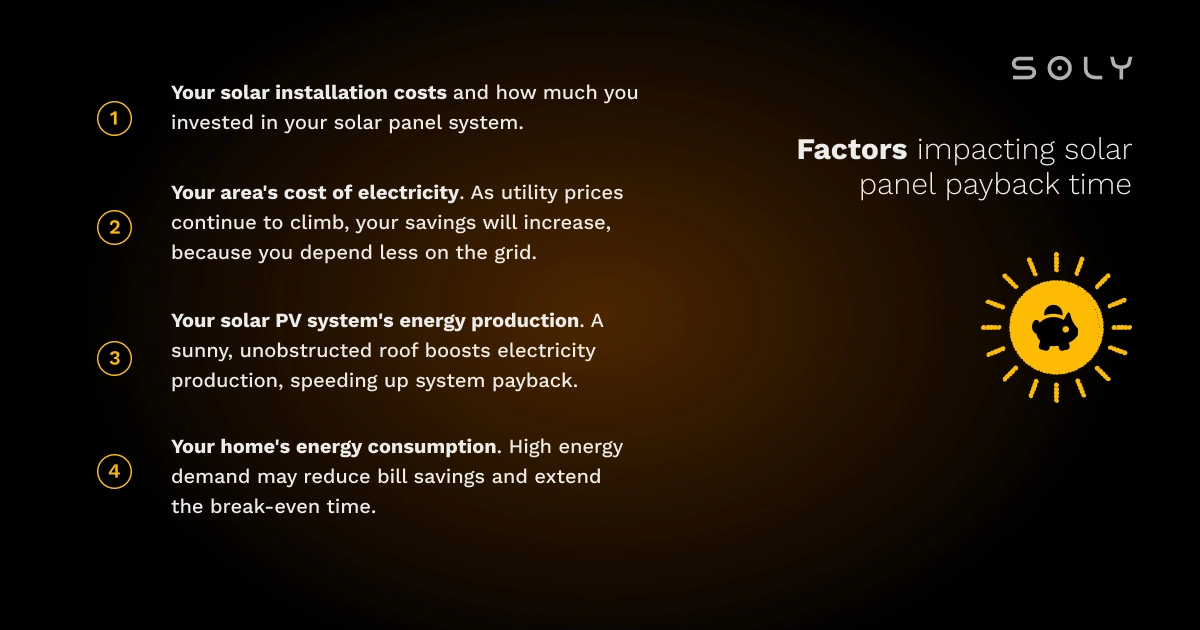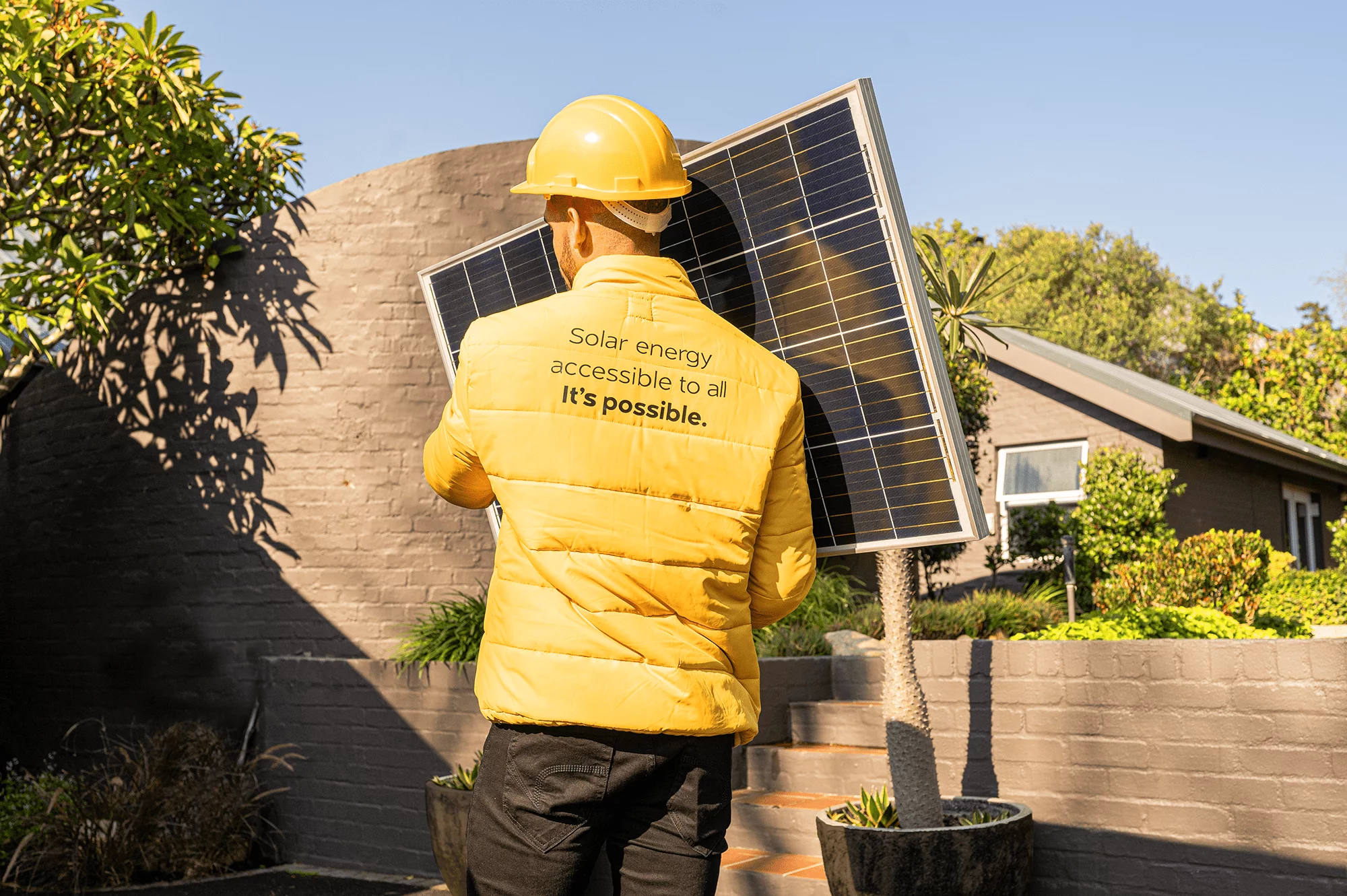Solar panel payback time: How long do solar panels take to pay for themselves?
How long do solar panels take to pay for themselves? This is one of the first questions homeowners ask when truly weighing their options and considering solar energy. With energy prices continuing to rise, understanding the payback period is pretty important to understand before deciding whether or not solar power fits your budget and lifestyle.
The payback period for solar panels varies. It depends on several factors like solar panels cost, the price of electricity in your area, and any solar panel grants or incentives you might qualify for. It also depends on just how efficient your solar PV system is and how much energy you typically use.
Some homeowners start seeing a return on their investment within 14 years. In some cases, this can stretch out to the span of 25 years. But with Soly, the average recoup on investment is around 7-8 years!
On this page, you’ll learn:
- How to estimate your own solar panel payback time.
- The key factors that influence how quickly solar panels pay for themselves.
- Tips to help you maximise savings and shorten your payback time.
Let’s begin!
- What is a solar panel payback period?
- Why should you care about your solar panel return on investment?
- Step-by-step guide: How to calculate your solar payback period (formula + examples + tool included)
- Factors that determine when you’ll break-even
- FAQ
- Final thoughts: How long do solar panels take to pay for themselves in the UK?
What is a solar panel payback period?
The solar panel payback period is the amount of time it takes for the money you save on your electricity bill to exceed the amount you spent on your solar panel system. In other words, it’s the point where your solar panels have fully “paid for themselves”.

This is an important figure for homeowners to grasp. That’s because it tells you when you can expect to start seeing a real return on your investment. Typically, this period is gauged in years. However, the length of time it takes can vary and truly depends on several factors:
- Installation costs: The upfront cost of installing your solar panels is one of the biggest forces shaping the payback period. Installation prices often depend on the system size, equipment quality, and the company you select.
- How you pay for the system: Some people elect to purchase their system outright, while others may lean toward financing options like loans or leases. If you’re paying interest on a loan, your payback period could be longer when compared to someone who paid in full upfront.
- Energy savings: Your electricity usage and the cost of energy in your area are also quite important here. If you use more energy, or live in an area with steep energy prices, your savings will add up much more quickly, which will shorten the payback period.
Understanding your unique circumstances will help you to accurately gauge just how long it’ll take to start reaping all the full financial rewards your solar system can bring.
Why should you care about your solar panel return on investment?
Understanding your solar panel return on investment (ROI) is vital if you wish to unleash the full potential of going solar. That said, a shorter solar payback period doesn’t just help you break even faster. It can also work to unlock financial and environmental advantages that you might not have even anticipated.

Let’s take a closer look at why this matters:
- Faster ROI: The faster you can recoup your initial investment, the sooner you can start reaping the benefits of pure savings. This is especially important with the rising energy costs in the UK. As of October 2024, if you install a 4kW solar system in London, the amount you’ll save each year will depend on how much time you spend at home. Here’s a breakdown based on data according to the Energy Savings Trust:
- If you’re home all day, you could save up to £500 a year.
- If you’re home mostly in the mornings, expect to save around £450 a year.
- For those home in the afternoons, savings could be around £430 annually.
- If you’re out until 4pm, you’re looking at savings of about £370 per year.
- For people out until 6pm, you could still save £350 a year.
With a shorter payback period, you’re increasing those savings over time, and funnelling more money back in your pocket.
- Increased profitability: After your system has paid for itself, every bit you save on energy costs is transformed into pure profit. This is why being able to grasp your payback period is so important. Once you’ve covered your installation costs, your monthly energy savings become your financial gains. If you’re able to send excess solar electricity back to the grid through the Smart Export Guarantee (SEG), you can even make money with your solar system.
- Lower financial risk: A shorter payback period means you’re less vulnerable to fluctuations in the energy market or changes in solar incentives. This means that as energy prices continue to climb, the benefit of producing your own power becomes even more valuable. By paying off your solar panel installation sooner, you’ll be less exposed to these changes, diminishing your financial risk in the long run.
- Greater energy independence: Once you break even, you’ll be generating free, renewable energy for your home. This essentially cuts down on your reliance on the national grid. It gives you more stability in the face of potential price hikes on electricity bills or supply disruptions. And as an added benefit, it aims to minimise your carbon footprint, which makes your home more sustainable.
- Increased property value: Homes that are equipped with solar panels often captivate the attention of buyers, especially if they come with a short payback period and ongoing energy savings.
To uncover even more about all there is to know about solar panels, be sure to explore our guide on the pros and cons of solar panels
Step-by-step guide: How to calculate your solar payback period (formula + examples + tool included)
If you’re curious about how long it will take for your solar panels to “pay for themselves”, this step-by-step guide can help you pinpoint the solar payback period. While you can run this calculation on your own, it’s wise to talk to a professional solar panel installer to make sure your figures are ‘on-the-money,’ so to speak.

Here’s a quick formula to get you moving forward:
- Figure out the total cost of installing solar on your home. This includes the price of the system, installation fees, and any associated costs like interest if you’re taking out a loan.
- Subtract any rebates, incentives, or tax credits. The UK offers several incentives, including the SEG, which allows you to sell surplus energy back to the grid. Some homes might also be eligible for additional regional or local incentives.
- Determine your net system cost. Once you’ve deducted any rebates and incentives, this is the actual cost of your system.
- Estimate your annual savings on electricity. Your solar installer or energy provider can help you estimate how much you’ll save on electricity each year. For example, homes in the UK save an average of £90 to £240 annually with solar.
- Calculate your solar payback period. Divide the net system cost by your estimated annual savings. This will give you the number of years it will take for your solar panels to pay for themselves.
Here’s the formula: (Net system cost) / (Annual savings on electricity) = Payback period (in years)
As an example, let’s say the total cost to install solar for your home is £7,000. You qualify for £2,000 in incentives and rebates, bringing the net system cost down to £5,000. You estimate that your solar panels will save you £500 per year on electricity as well as you earn £200 annually by selling excess energy back to the grid. Dividing £5,000 by £700 gives you a payback period of 7 years.
Bear in mind that this calculation gives you a rough estimate. However, energy costs and incentives can shift as time goes by. This means that your actual savings could fluctuate and land either higher or lower.
That said, if you do not want to get into trouble calculating all these numbers alone, but still figure out just what applies to your situation, then you can use Soly’s online configurator tool and get an estimate from a solar expert.
Caption: Save money with solar panels, use Soly’s configurator tool for personalised savings and estimates from a solar expert.
Factors that determine when you’ll break-even:
There are several factors that can impact how quickly you can expect your solar panels to “pay for themselves” and start producing nothing but pure savings.

Here’s a breakdown of the most important elements to take into consideration:
#1: Your solar installation costs
The most significant factor that determines your solar payback period is just how much you invested in your system. This includes all upfront costs such as the equipment, solar installation fees, and any interest or charges if you finance the system.
To calculate your true cost, be sure you:
- Include taxes and fees associated with the installation.
- Deduct any solar incentives you qualified for, such as the UK’s SEG or other regional grants.
Reduce cost with solar panel grants
Solar panel grants and incentives can significantly reduce the overall cost of your solar installation, helping you achieve a quicker payback period. As mentioned, the UK offers programs like the SEG, which pays homeowners for any excess electricity that they send back to the grid.
Reduce upfront cost with solar panel financing
Solar panel financing solutions like loans and solar leases give you a way to spread out the upfront costs that come along with installing solar panels. This can make solar much more accessible. However, it can extend the payback period if you’re paying interest.
#2: Your area’s cost of electricity and rate of increase
One factor that’s overlooked most of the time is the cost of electricity in your area. The steeper your local electricity rates are, the more you’re going to be able to save in the long run by producing your own power.
As utility prices continue to climb, your savings will increase, because you depend less on the grid.
#3: Your solar PV system’s energy production
The amount of electricity your solar PV system generates plays a pivotal role in calculating your payback period. Indubitably, this is going to depend heavily on:
- Roof space: Larger roof areas have the room to accommodate more solar panels. This results in greater electricity production.
- Sunlight exposure: Solar panels perform optimally in sunny environments, so a home with ample sunlight will generate more energy than one in a shaded area.
If your roof basks in a sunny, open space, you’ll produce more electricity and pay off your system faster. Conversely, if your home is in a shaded area, you may need extra time to break even.
#4: Your home’s energy consumption
Your household’s energy consumption heavily influences your solar payback period.
In some cases, a solar system can cover up to 100% of your energy needs, meaning your electricity bill could drop down to nearly zero. This is especially the case in the most ideal conditions such as a south-facing roof with no shade and when sized appropriately.
For example, a 4kW solar system can produce around 3,400 kWh per year, which could cover the total electricity usage for smaller to medium-sized homes in the UK. However, achieving this truly depends on perfectly aligning your system size to your household’s energy needs and optimising your home’s energy efficiency.
For homes with high energy demand, solar may only offset a portion of the costs. This could result in smaller utility bill reductions and possibly lengthening the time to break even.
Improving your home’s energy efficiency before installing solar panels can help. Undoubtedly, a more energy-efficient home will require a smaller and less costly solar panel system to meet your energy needs.
FAQ
What is the average payback on solar panels?
On average, the payback period in the UK for solar panels is between 7 and 25 years. This can get shorter or longer based on factors such as location, system size, energy consumption, and more.
How much do you get back from solar panels?
Essentially in the UK, you can save between £90 and £240 per year on your power bills with solar panels, with additional income from selling excess energy back to the grid through the SEG.
How much do I get for selling electricity back to the grid in the UK?
Under the Smart Export Guarantee (SEG), homeowners can earn 5-6p per kWh for selling surplus electricity back to the grid.
Final thoughts: How long do solar panels take to pay for themselves in the UK?
The solar panel payback period takes anywhere between 7 and 25 years. It’s influenced by solar panel installation expenses, energy usage, and available incentives like the Smart Export Guarantee (SEG).
Additionally, factors such as the rising price of electricity, a well-placed solar system, and energy-efficient home improvements can shorten your payback period and boost your long-term savings.
By grasping these elements and leveraging tools that are at your disposal such as Soly’s online calculator, you can estimate your payback period, and start reaping the rewards of clean, renewable energy.
Why choose Soly for your solar panel needs?

At Soly, we make solar energy accessible and ensure your photovoltaic system lasts as long as possible, performing at its best. Here’s why we’re the ideal choice for your solar energy journey:
- Affordable financing: We understand that upfront costs can be a barrier to going solar. That’s why we partner with Hometree Finance to make it easier for you to switch to clean, renewable power and start saving on your energy bills.
- Referral benefits: Soly offers the best referral scheme in the solar market. As a Soly customer, you can earn £300 for each friend you refer who installs a system with Soly—with no limits! This can significantly help reduce your payback period. For example, one of our customers, Martyn, managed to reduce his payback period by nearly a year by referring just three friends.
- High-quality panels: We use only the best solar panels, offering monocrystalline solar panels from Jinko Solar. Known for their efficiency and durability, these monocrystalline solar panels can last for up to 40 years, ensuring you get the most out of your investment.
- Trusted reputation: Soly is proud to be highly rated on platforms like TrustPilot and Google and recognized as a certified Which? Trusted Trader. We’ve built a reputation for excellence, earning the trust of countless satisfied customers, with our commitment to quality evident in every installation.
- Accredited installers: We work exclusively with local installers nationwide who are accredited by HIES, TrustMark, and MCS, ensuring that your solar system is installed with the highest industry standards in mind. Proper installation plays a huge role in maximising the lifespan of your solar panels.
- Expertise you can trust: With over 10 years of experience in the solar industry, we know how to deliver the best solar solutions tailored to your needs. Our team of experts will ensure your system is designed to last.
- Peace of mind: We provide up to 25-year guarantees for our solar panels and 15-year guarantees for our solar batteries. This means you can have peace of mind knowing your investment is protected for decades to come.
Reach out to our solar experts today to discover how Soly can help you transition to clean, renewable energy with the best products and financing options.